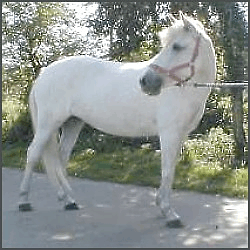
HORSES OF THE WORLD
| CAMARGUE
Origin: |
 Photo supplied by Horse Directory Australia © |
History:
The breed originated in the Camargue, the inhospitable Rhone Delta in
southern France, probably dating back to 15,000 BC where cave paintings of Lascaux depict
horses with a strong resemblance to the breed. Over the centuries the native horses were
influenced by North African blood but retained some of their primitive characteristics in
particular their heavy, square head. In the harsh terrain developed a tough, sure footed
little horse strong enough to carry an adult rider over the most treacherous wetlands. The
Camargues were capable mounts for the guardians who looked after the herds of fighting
bulls raised in the area. Herding the fighting bulls was the breed's traditional role.
In the Camargue the herds enjoy a semi wild existence for most of the year. They are
rounded up annually for inspection, branding of young horses, selection of breeding stock
and gelding of non breeding male horses. These days most pastures are fenced off and large
areas are drained for the cultivation of crops leaving little need for the herdsmen but
the Camargue still remains a feature of the region. It was not until January 1968 that the
breed was officially recognized.
The small, grey, semi wild Camargue has been a romantic inspiration to poets and artists
for many centuries.
Characteristics:
Head: fairly large, square head; straight or slightly convex profile;
large, expressive eyes; short, wide set ears
Neck: short, muscular
Shoulders: short, upright; pronounced withers
Body: fairly short back; deep chest, sloping croup, muscular
hindquarters
Legs: strong, well formed limbs; big knees
Feet: sound, very hard
Tail: long, bushy
Color: always grey; born black or brown, turn grey when they
mature
Height: 13.1 to 14.1hh
Temperament: good natured, obedient, lively
Qualities: tough, strong, sure footed, courageous, easy to
train
Today:
Camargues are used as riding horses for tourists who visit the Camargue
region which is famous for its abundant wildlife. Because they are easy to train they
often work in the Circus performing various tricks.
![]()